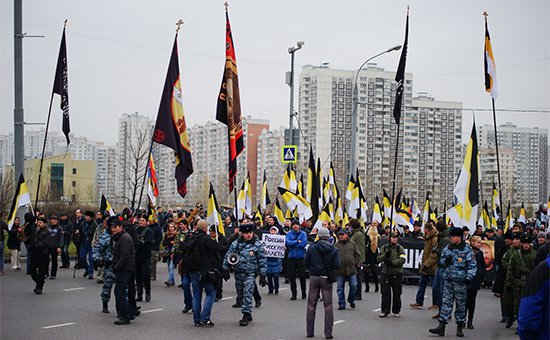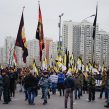
Cooptation and Repression: The Kremlin’s Approach Russian Nationalists
Publication: Eurasia Daily Monitor Volume: 12 Issue: 203
By:

The now-annual extreme-nationalist “Russian March” in Lublino (a working-class district in Moscow, populated mostly by ethnic Slavs), on November 4—National Unity Day—saw a sharply reduced number of marchers this year. Last Wednesday’s march in the Russian capital had only about 700 participants, whereas previous years’ marches had attracted between 5,000 and 10,000. As in previous years, the demonstration brought together a disparate number of nationalist groups, including “Pamiat,” “Pan-Slavists,” the “Russian Human Rights League” and the “Right Column.” Many in the crowd chanted “no war between brother nations” and “peace with Ukraine.” Others called out “there will be no peace on Russian land while a Chekist [a reference to President Vladimir Putin, a former colonel in the Soviet KGB] sits in the Kremlin!” and “down with dictators”—an echo of the importance the nationalist movement played in the large-scale anti-regime protests led by opposition anti-corruption blogger and activist Alexei Navalny, in 2011 and 2012 (Sova-center.ru, November 5). A similar lackluster turnout could be observed at the “Russian Marches” held in other cities across the Russian Federation: the demonstration in Astrakhan had only 4 confirmed marchers, 250 came out in Volgograd, more than 100 marched in Ekaterinburg, 20 joined in Kazan, and 70–250 took part in Krasnodar. Reports indicate that the extreme nationalists’ march was canceled in St. Petersburg, as a sign of respect for those who lost their lives in the Metrojet Flight 9268 crash, in Egypt (Sova-center.ru, November 5). Just a few years ago, the Russian March had seemed a potent source of opposition activity in the country, but for the time being at least, its impetus appears to have waned.
Such dwindling of the strength of the extreme right opposition in Russian can be attributed to two reasons: repression and cooptation. Right before the Russian March was due to take place, the leader of the DPNI racist movement, Alexander Belov, and the leader of the skinhead gang “Slavic Union,” Dmitry Demushkin, were both placed under extended house arrest by the authorities (see EDM, October 23). The two men were prominent figures in the self-styled “ethno-political movement” The Russians, the last surviving nationalist organization that had taken part in the Navalny-led protests years earlier. In prohibiting two of the most prominent leaders of the march from attending, the Kremlin effectively repressed the marches. Indeed, photographs taken at the demonstrations in Moscow show protestors carrying placards calling for “freedom to Belov” and “freedom to Demushkin” (Rmarsh.info, November 5).
In addition to repressive tactics, the ruling regime has also acted to commandeer elements of the nationalist juggernaut, as illustrated by the presence of several other, rival marches that also took place on November 4, in Moscow. The first rival march took place in the Shchukino district of Moscow and was titled “The Russian March—for a Russian Revanche.” Organized by the “Russian National Front,” the demonstration was advertised as being “for responsible citizens who love their Motherland and hate her enemies” (Svoboda.org, November 4). The public event backed a number of causes, including the seemingly abandoned “Novorossiya” project (“New Russia”—see EDM, July 2, 2014). The Russian National Front–sponsored march has been an annual rival to the Belov-Demushkin march for a number of years (Igpr.ru, September 11). The Russian National Front has clearly heard the message that Putin’s Russia is fighting for its cause and joined forces with it.
Another rival march took place in the center of Moscow, along Tsvetnom Boulevard, and was organized by the social movement “Russian World” (“Russkiy Mir”). The march was proposed to “honor the memory of those Russians killed in the plane crash in Egypt” and “the victims of militias in the first battle for Donetsk airport.” Reports about the numbers of participants have been sketchy, but the online group has over 4,000 members (Vk.com, November 4). As with the march organized by the Russian National Front, the “Russian World’s” alternative demonstration highlights the channeling of domestic nationalist sentiment by the Russian state.
The third alternative march, by far the largest, was a pro-Kremlin Russian event led by the organization “We Are One.” The march was joined by a column of the organization “Tigers of the Motherland,” whose leader, Vladimir Laktyushin, told the media that the column would accept “all sane Russian patriots, except those who [support] Ukraine against Russia. Reports suggest that as many as 85,000 people participated in this demonstration (Svoboda.org, November 4). Unlike the other two marches, the third alternative march was completely new—though clearly organized by the Kremlin or someone close to it.
This year’s “Russian March” and the series of parallel demonstrations shed further light on the regime’s tactics of commandeering domestic nationalist forces and repressing those who persist in opposing the government. Given Putin’s stratospheric approval ratings, such an approach seems to be working well. Yet, this strategy’s longer-term risks are still possible. According to Vera Alperovich, of the Moscow-based SOVA Center for Information and Analysis, Russia’s extreme nationalists are in a state of confusion and anger about what is happening domestically and how they should proceed from this point. Some now believe that their groups’ strategies are not working as an effective means of opposing the regime. Whole cells of organizations, such as “the Russians” in Astrakhan, have become more radical and say they are ready to move on to violent guerilla methods of continuing the struggle (Svoboda.org, November 4). Unless the Kremlin can continue to buy the acquiescence of the radical nationalists with foreign adventurism (such as with the Syria campaign), the situation in Russia may quickly become extremely unstable.




